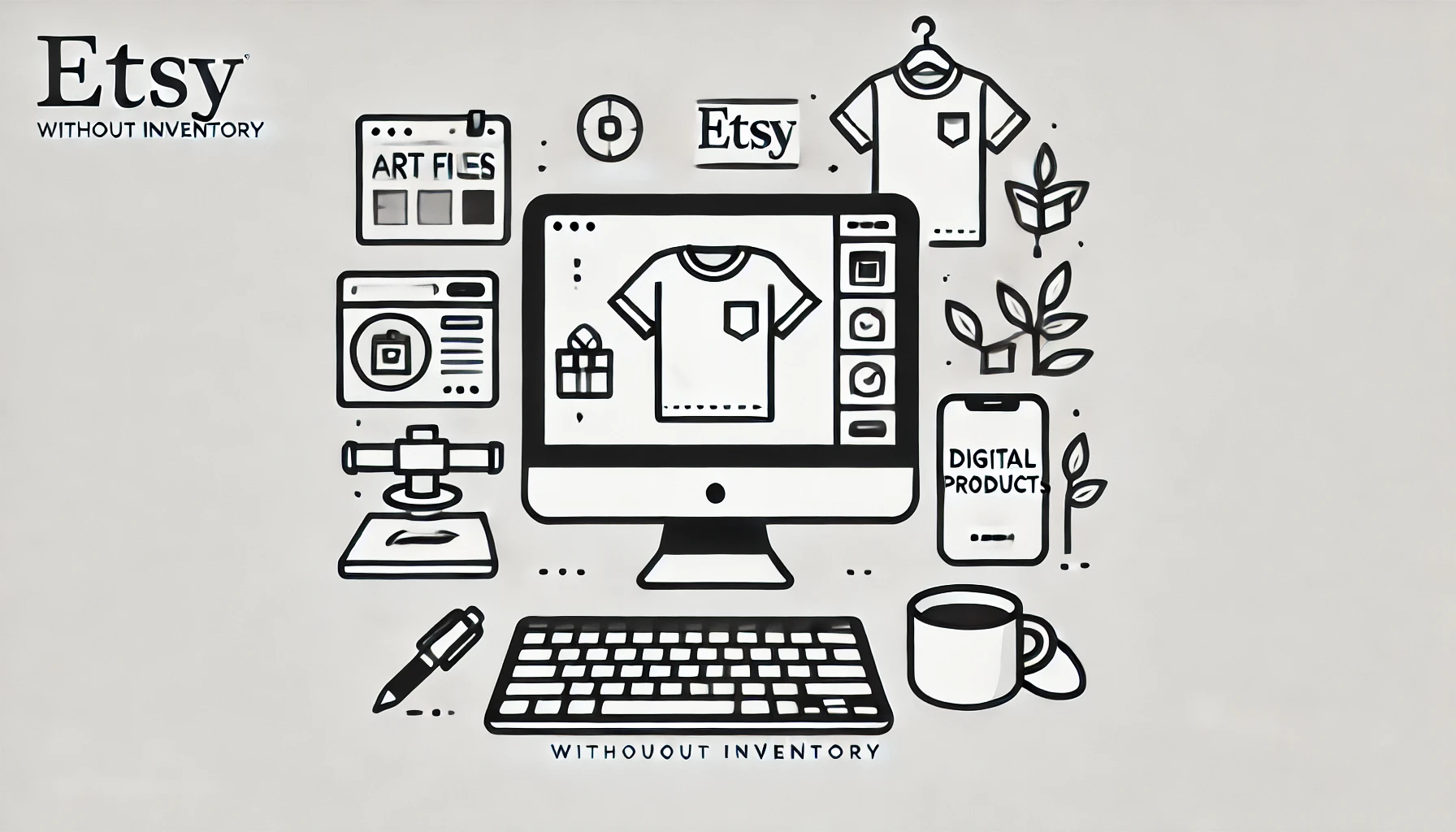
Starting an Etsy shop can be a fantastic way to share your creativity with the world. But what if you don’t have a bunch of products stacked up in your home or space to store inventory? Don’t worry! You can still sell on Etsy without keeping any physical products in stock.
Depending on the type of product you want to sell, you can choose from selling Digital products where a user download the files uploaded by you or you can sell physical products designed by you but fulfilled by other services like Print-on-Demand companies.
Selling Digital Products on Etsy
Digital products are a popular choice for Etsy sellers who want to avoid dealing with physical inventory. Digital products are files that customers can download instantly after purchasing. These kind of products have practically unlimited inventory and can help in creating a source of passive income in the long run. Here’s how you can get started.
Types of Digital Products
- Printable Art: Create beautiful designs that people can print at home and frame on their walls.
- Digital Planners: Design planners or journals that customers can fill out on their devices.
- E-books: Write and sell books or guides on topics you’re passionate about.
- SVG Files: Create designs for crafters who use cutting machines like Cricut or Silhouette.
- Social Media Templates: Make easy-to-use templates for Instagram, Pinterest, or Facebook posts.
- Invitations and Greeting Cards: Design cards and invitations for events like weddings, birthdays, or holidays.
Tools and Requirements
To create digital products, you’ll need some sort of set up at home to create these files. Some of the basic tools include:
- Design Software: Programs like Adobe Photoshop, Illustrator, or free options like Canva can help you create your designs.
- Computer: A reliable computer with enough power to handle design software.
- Creativity: Think about what people might want to buy. Trends change, so stay updated on what’s popular.
Pros and Cons of Selling Digital Products
Pros:
- No Shipping: Once you create the product, it’s available to customers instantly. No need to worry about shipping.
- Passive Income: You can make sales even when you’re not actively working.
- No Inventory: You don’t need to store or manage physical products.
Cons:
- Competition: There are many sellers offering digital products, so standing out can be challenging.
- Intellectual Property: Your designs can be easily copied, so you may need to take extra steps to protect your work.
Print-on-Demand Services for Physical Products
Print-on-demand (POD) is another great option if you want to sell physical products without holding inventory. With POD, you create the design, and when someone orders it, the product is printed and shipped by the POD company. This is the best way to test your designs without investing too much in the inventory or production. If the product is successful you can look into ways to fulfill it at your preferred location to better control your profit margins.
Common Print-on-Demand Product Types and Categories
- Apparel: T-shirts, hoodies, sweatshirts, leggings, and socks are some of the most popular items. You can customize these with your own designs.
- Home Decor: Products like throw pillows, wall art, blankets, and tapestries allow customers to add a personal touch to their living spaces.
- Accessories: Items such as tote bags, hats, phone cases, and backpacks are great for everyday use and can be customized with unique designs.
- Stationery: Notebooks, planners, and greeting cards are perfect for those who love to keep organized or send personalized notes.
- Mugs and Drinkware: Custom coffee mugs, travel mugs, and water bottles are popular gifts and everyday essentials.
- Posters and Prints: High-quality posters and art prints allow customers to decorate their homes or offices with your designs.
Popular Print-on-Demand Services
- Printful: Offers a wide range of products, including clothing, home decor, and accessories.
- Printify: Provides access to multiple print providers, allowing you to choose the best price and quality.
- Gooten: Offers a variety of products and has an easy-to-use interface for sellers.
- TeeSpring: Known for custom apparel, but also offers other products like phone cases and home goods.
- Redbubble: Focuses on artistic designs and has a large marketplace to showcase your products.
- Society6: Similar to redbubble, you upload your design on the website and select products to sell.
Pros and Cons of Using Print-on-Demand
Pros:
- No Inventory: You don’t need to invest in products upfront or worry about storage.
- Variety: You can offer a wide range of products without managing stock.
- Easy to Start: Many POD services integrate directly with Etsy, making it easy to get started.
Cons:
- Lower Profit Margins: Since the POD service handles printing and shipping, you earn less per sale.
- Quality Control: You don’t see the product before it ships, so ensuring consistent quality can be challenging.
- Shipping Times: Because products are made on demand, shipping can take longer, which might affect customer satisfaction.
- Image requirements: Each POD service has specific dimensions for each product type. It can be overwhelming to create designs for each product type. So choosing the right POD service is very important to reduce overload in your workflow.
Selling on Etsy without inventory is not only possible but can also be a rewarding experience. Whether you choose to create digital products or use print-on-demand services for physical products, each option has its benefits and challenges.
Digital products offer the advantage of instant delivery and passive income, but they come with stiff competition and potential intellectual property concerns. Print-on-demand services allow you to sell physical products without upfront investment or inventory management, though you may face lower profit margins and longer shipping times.
By carefully considering your strengths, interests, and resources, you can choose the right path for you and start your Etsy journey with confidence. Remember, every successful seller started as a beginner, and it’s okay to take things one step at a time.
Happy selling!